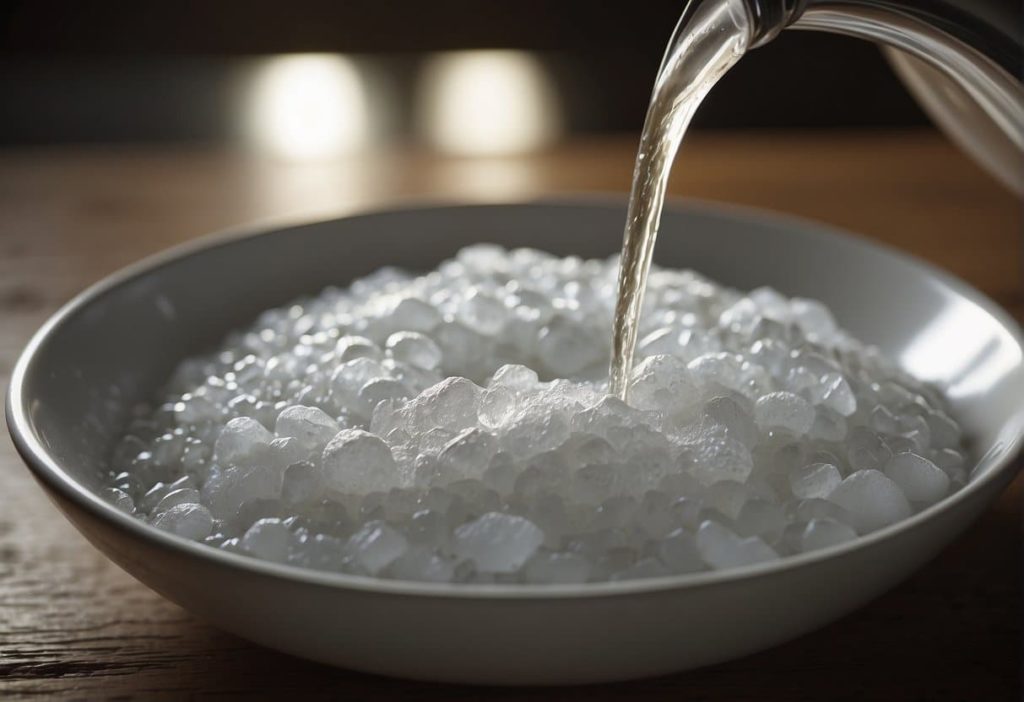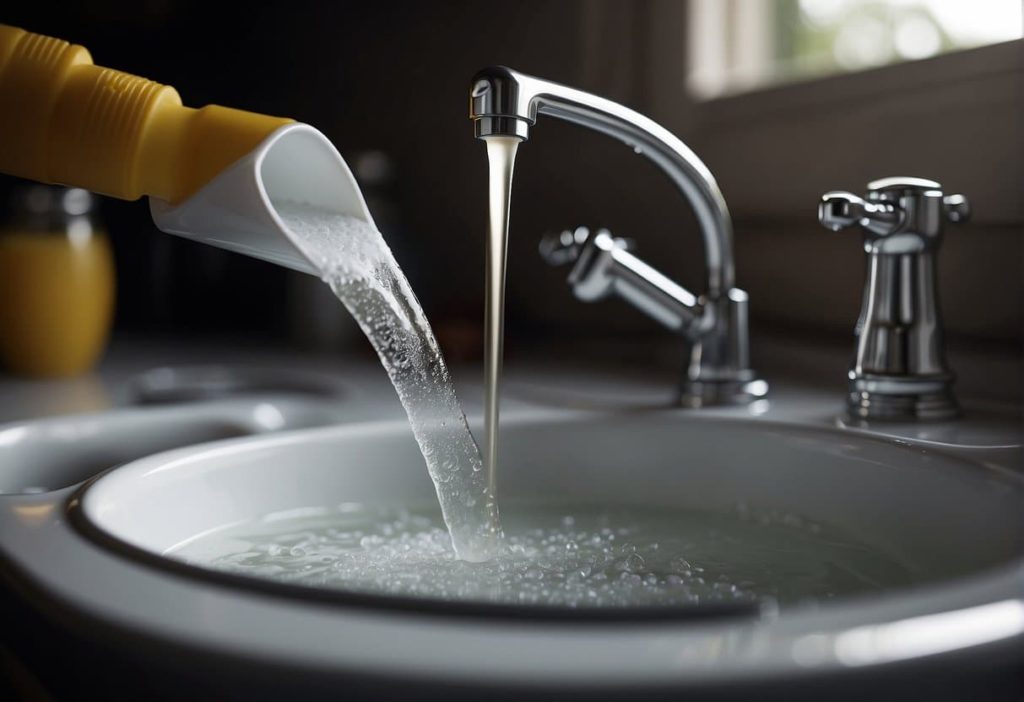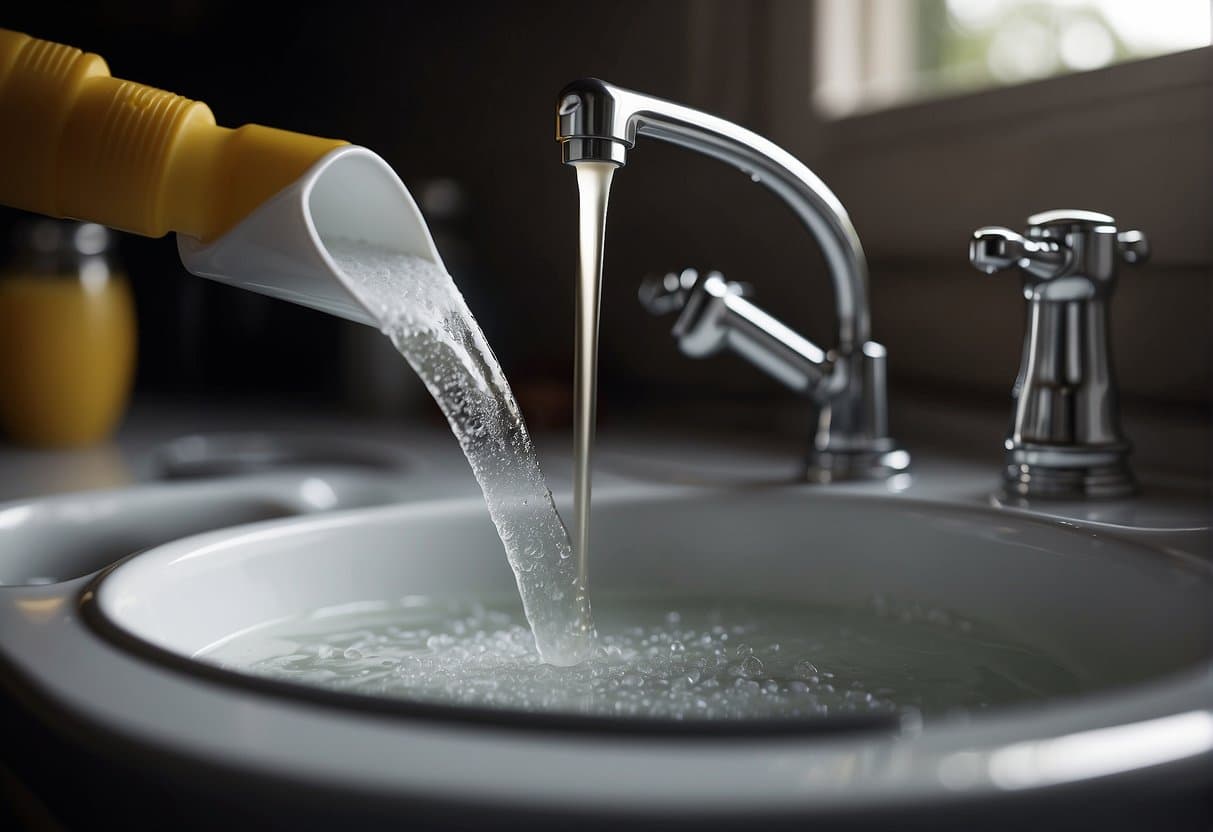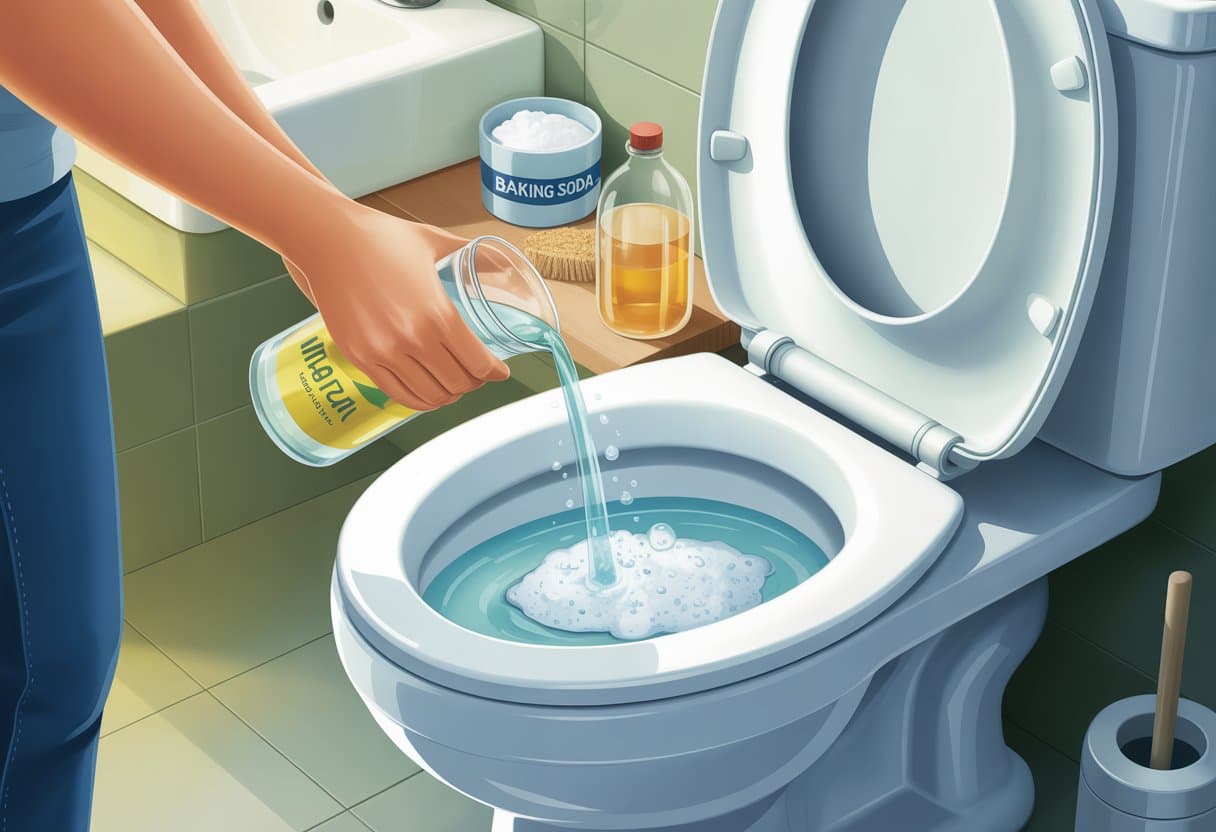Look, we’ve all been there. You’re standing over a sink that’s draining slower than Seattle traffic on I-5, and you’re wondering if you should dump another bottle of Drano down there or finally call a plumber.
Here’s what most homeowners don’t realize, and something we see constantly in our service calls across Snohomish and King Counties, about 70% of drain clogs can actually be cleared with two ingredients you probably have sitting in your kitchen right now. When you need to unclog a stubborn drain without harsh chemicals, these simple cleaning materials can save you both time and money.

Baking soda and vinegar. That’s it.
This isn’t some Pinterest hack that sounds good but doesn’t work. We’ve been recommending this natural cleaning method to our clients for years, and honestly? It’s saved them hundreds in unnecessary service calls. The vinegar solution breaks down buildup while the soda creates an abrasive action that helps clear stubborn blockages. Plus, it’s way better for your pipes than those harsh chemical cleaners that promise the world but often deliver pipe damage instead.
When you combine these two household cleaning agents, you get a powerful reaction that can tackle most minor drain issues. The beauty of this approach is that both baking soda and vinegar are safe for all types of plumbing materials, from old cast iron to modern PVC systems.
But here’s the thing, it only works if you do it right. And that’s what we’re going to walk through today. Whether you’re dealing with sink drains in your kitchen or bathroom drains that won’t clear properly, this method can help you avoid the expense of professional drain cleaning services for minor issues.
Why Your Drain Keeps Getting Clogged (And It’s Not What You Think)
Before we dive into the solution, let’s talk about what’s actually happening in your pipes. Most people assume it’s just hair and soap scum, but after clearing thousands of drains in the Seattle area, we’ve learned it’s usually a combination of materials working together to create the perfect storm of blockage.
The usual suspects:
- Hair mixed with soap residue (creates a sticky web that catches everything)
- Kitchen grease that hardens as it cools in your pipes
- Food particles that should’ve gone in the garbage disposal or trash
- Mineral buildup from our Pacific Northwest hard water
- Bathroom products that accumulate in the drain trap over time
Last month, we had a client in Edmonds whose kitchen sink had been draining slowly for weeks. She kept pouring boiling water down it, thinking that would help dissolve whatever was blocking the flow. When we used our drain snake to clear the line, we pulled out what looked like a small beaver dam made of grease, coffee grounds, and something that might have been pasta (we didn’t ask). The point is, most drain clogs build up gradually in the trap and pipes. That’s why the baking soda and vinegar cleaning approach works so well for maintenance, it breaks down the sticky materials before they become a real problem that requires professional intervention.
The Science Behind Baking Soda and Vinegar Solutions
When baking soda (sodium bicarbonate) meets vinegar (acetic acid), they create a powerful reaction that produces carbon dioxide bubbles. Those bubbles? They’re like tiny scrub brushes working inside your pipes to clean away buildup and debris.
But it’s not just the fizzing action that makes this cleaning method so effective. The alkaline baking soda breaks down organic materials like grease and hair, while the acidic vinegar dissolves mineral deposits and soap scum that accumulate over time. When you pour these two cleaning agents together, they tackle different types of buildup simultaneously, making this one of the most comprehensive natural cleaning solutions available.
This dual-action approach is why we recommend the soda and vinegar combination over single-ingredient solutions. The vinegar alone might dissolve some mineral deposits, but it won’t break down grease effectively. The baking soda by itself can absorb odors and provide mild abrasive action, but it needs the acid in vinegar to create the bubbling reaction that really gets into the crevices of your drain system.
One thing we tell our clients though, this works best on organic drain clogs. If you’ve got a wedding ring or a toy car stuck down there, this cleaning method isn’t going to help. (We’ve retrieved stranger things, trust me.) For mechanical blockages, you’ll need either a drain snake or professional assistance to clear the obstruction.
Getting Ready: Materials You’ll Need and How to Stay Safe
This is pretty straightforward, but let’s do it right:
Your supply list:
- 1/2 cup baking soda (the standard white powder, not baking powder)
- 1 cup white vinegar (regular household cleaning vinegar works perfectly)
- A kettle or large pot for heating water to boiling temperature
- Hot tap water for initial rinsing and final cleanup
- Clean cloth or rubber drain plug to seal the opening
- Rubber gloves (optional, but your hands will thank you when you’re cleaning around the drain opening)
Safety stuff we actually care about: Work in a ventilated area, the vinegar smell can be strong, especially in smaller bathroom spaces. Keep kids and pets away from the work area while you’re doing any cleaning procedures. And please, wear gloves if you’re squeamish about what might come up from your drain during the cleaning process.
We had a client in Lynnwood who decided to triple the recipe thinking more soda and vinegar would work better for her stubborn kitchen drain. The reaction was so vigorous it actually pushed gunk back up through her bathroom sink overflow. The excess pressure from too much vinegar solution created more problems than it solved. Learn from her mistake, stick to the recommended measurements for effective cleaning without creating water damage issues.
The Step-by-Step Soda and Vinegar Process That Gets Results
Step 1: Clear the Obvious Stuff Remove any visible hair, food particles, or debris from around the drain opening. Take off the drain cover or stopper if you can, you want that baking soda to get down into the pipe, not sit on top of a hair mat. For kitchen sink situations, check your garbage disposal first and run it to clear any loose food particles that might interfere with the cleaning process.
Step 2: The Baking Soda Pour Pour 1/2 cup of baking soda directly down the drain opening. Try to get the soda distributed evenly rather than dumping it all in one spot. Let it sit for about 5 minutes to settle into the pipe and begin working on the buildup. The soda will start absorbing odors and beginning the breakdown process even before you add the liquid component.
Step 3: Add the Vinegar Slowly pour 1 cup of white vinegar down the drain. You’ll hear it start to fizz immediately as the vinegar reacts with the soda, that’s exactly what you want for effective cleaning. The slower you pour the vinegar, the better the reaction will be throughout the pipe system. This creates a foaming action that helps break apart materials stuck to the pipe walls.
Step 4: Seal and Wait Cover the drain with a cloth or plug to keep the cleaning reaction contained. This creates pressure that helps push the bubbling action deeper into the drain clog and surrounding buildup. Wait 15-30 minutes to allow the soda and vinegar mixture to work on breaking down the obstruction. (We usually tell clients to set a timer, it’s easy to forget and come back three hours later.)
Step 5: The Hot Water Flush Remove the cover and slowly pour a kettle of boiling water down the drain to wash away the loosened debris and any remaining soda mixture. Follow up with hot water from the tap to make sure everything’s flowing smoothly and to rinse any residual cleaning agents from the pipe walls.
A client in Everett called us last week panicking because the fizzing seemed too vigorous. “Is my pipe going to explode?” No, your pipe isn’t going to explode. That reaction is actually a good sign, it means the cleaning method is working to break down the materials causing the blockage.
When Baking Soda and Water Methods Aren’t Enough

Sometimes you need backup options. Here are two techniques we recommend before calling in the professionals:
The Salt and Heat Method Mix 1 cup of table salt with a gallon of hot water that’s been heated to near boiling. Pour the solution down slowly and let it sit for a few minutes. This works particularly well for grease clogs in kitchen sink drains where cooking oils have solidified in the pipes. The salt acts as an abrasive while the hot water melts away fatty deposits.
The Wire Hanger Technique
Straighten out a wire coat hanger, leaving a small hook at one end. Fish it down the drain to pull up hair clogs and debris. Be gentle, you don’t want to scratch your pipes or push the drain clog deeper into the system. This manual approach works especially well in bathroom drains where hair tends to collect in the trap.
But here’s what we’ve learned after years of service calls: if you’ve tried these cleaning methods twice and you’re still having drainage issues, it’s time to call a professional. Continuing to pour different solutions down a persistently clogged drain often makes the problem worse and more expensive to fix. Sometimes you need a professional drain snake or specialized equipment to reach clogs that are deeper in the system.
Keeping Your Drains Happy with Preventive Materials and Techniques

The best approach to drain maintenance is the kind you do before you need it. Most of our repeat customers in the greater Seattle area have learned this lesson the expensive way.
Weekly habits that prevent problems:
- Use sink strainers to catch hair and food particles before they enter your drains
- Never pour grease down kitchen drains (let it solidify and scrape into the garbage for proper disposal)
- Run hot water after each use to keep oils and soap moving through the system
- Do the baking soda and vinegar cleaning treatment monthly as preventive maintenance
- Clean your garbage disposal weekly with ice cubes and citrus peels
What not to flush or send down any drain: Coffee grounds, “flushable” wipes, cat litter, medication, paint, or anything that isn’t water, human waste, or toilet paper. These materials can create serious clogs in your trap or deeper in the pipe system that require professional cleaning to resolve.
We have a regular client in Mukilteo who used to call us every six months for kitchen drain cleaning services. After we taught her about proper grease disposal and monthly maintenance with soda and vinegar, she hasn’t needed a service call in over two years. That preventive approach has saved her around $800 in plumbing bills. Regular cleaning with simple household materials like baking soda and vinegar can extend the life of your drains and keep water flowing smoothly throughout your home.
Dealing with Persistent Drain Clogs: When to Call Professionals

Some drain issues are beyond the DIY methods, and that’s okay. Here’s when you should pick up the phone instead of reaching for more baking soda:
- Water backing up into other drains (indicates a main line problem)
- Sewage smells coming from multiple drains throughout your home
- Gurgling sounds when you run water (suggests venting issues)
- Water draining slower after multiple cleaning attempts with soda and vinegar
- Any signs of water damage around fixtures or in surrounding areas
Professional drain cleaning isn’t just about clearing the immediate problem. We can identify issues before they become emergencies, inspect your pipes for damage, clean your drain trap thoroughly, and give you specific maintenance advice based on your home’s unique plumbing system. Our team has the proper tools, including professional-grade drain snakes and hydro-jetting equipment, to tackle even the most stubborn clogs that household cleaning methods can’t handle.
The Bottom Line on Soda and Vinegar Water Solutions

The baking soda and vinegar cleaning method works for routine maintenance and minor drain issues. It’s safe, environmentally friendly, and costs about 50 cents per treatment instead of $15 for a bottle of chemical cleaner. When you need to unclog a slow-running drain or clean away odor-causing buildup, this natural approach using common household materials can save you both money and harsh chemical exposure.
But it’s not magic. Severe drain clogs, main line issues, or problems with your home’s plumbing system need professional attention. The key is knowing the difference and not waiting until a small problem becomes a plumbing emergency that requires extensive cleaning or pipe replacement.
If you’re dealing with persistent drainage issues in Snohomish or King County, don’t spend another weekend fighting with your pipes. Give Danika Plumbing a call, we’ll get your drains flowing properly and teach you how to keep them that way with proper maintenance and the right cleaning techniques.
Because honestly? We’d rather help you prevent problems with regular maintenance cleaning than show up at 8 PM on a Sunday for an emergency call to unclog a completely blocked drain. (Though we’ll do that too if you need us.)



